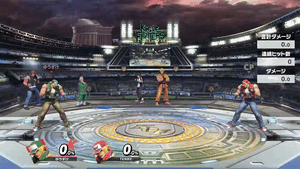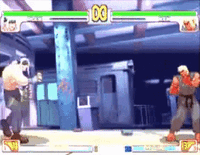User:The Other Jared/Charge partitioning: Difference between revisions
mNo edit summary |
m (Hiding mainspace categories) |
||
| Line 22: | Line 22: | ||
==References== | ==References== | ||
{{reflist}} | {{reflist}} | ||
<!--[[Category:Advanced techniques]] | |||
[[Category:Advanced techniques]] | [[Category:Terry (SSBU)]]--> | ||
[[Category:Terry (SSBU)]] | |||
Latest revision as of 12:16, July 17, 2021

Charge partitioning is an advanced technique exclusive to Terry's Rising Tackle in Super Smash Bros. Ultimate. This technique allows Terry to store the charge for a charged Rising Tackle in sections, thus the term "partitioning". While Crack Shoot uses a similar system for determining whether to reverse it in the air, charge partitioning does not apply, meaning it is exclusive to Rising Tackle.
How to perform[edit]
The charge for Rising Tackle requires 24 frames to be stored. However, this charge time is very lenient; when down is released, there is an 11 frame leeway to continue charging, and a 9 frame leeway to perform the move. Within this leeway time, other actions (such as walking or jumping) can be taken, and the charge will be resumed as long as down is pressed again in time. Down can also be held during certain actions, such as dashing, which counts toward the charge. As such, this allows for storing the charged Rising Tackle over a longer span of time without leaving Terry vulnerable. It is considered simpler to perform on a SmashBox, due to easier access to downward inputs.
Utility[edit]
Generally, charge partitioning allows Rising Tackle to be an excellent option against jump-ins in the neutral game, though it is committal. It is also one of the most effective ways to use a charged Rising Tackle out of shield. Without having to use shield tilting while waiting 24 frames for the charge to store, the move becomes very powerful, allowing Terry to potentially KO opponents for merely touching his shield. This, considering the frame 5 intangibility, gives Terry what's effectively a frame 5 out of shield option if the opponent continues to pressure him.
Thanks to the intangibility, using charge partitioning alongside DI or SDI can also allow Terry to punish overextensions, such as ladder combos, with extreme potency. With its already incredible kill power boosted by being closer to the ceiling, opponents can be KOed at incredibly low percentages. In a similar vein, charge partitioning also works excellently alongside COIL or command special inputs to make a charged Rising Tackle more reliable for recovery.
Charge partitioning is also used to enable combos, particularly between neutral attack's first and second hits[2]. This allows for Terry to get a much more consistent jab combo rather than with Power Dunk, which is notoriously inconsistent due to SDI. Mixing these up is popular in competitive play to score KOs more easily, forcing a 50:50 on the opponent.
Origin[edit]
Charge partitioning was originally a glitch in Street Fighter III[3]. However, it was adopted by some fighting games to make charge inputs easier to do, though it was eventually replaced with techniques like charge buffering. It's typically very difficult to do, with small frame windows; compared to traditional fighting games, Ultimate's iteration of charge partitioning is considerably easier to perform.
